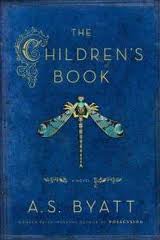This
675 page (with small print) multi-generational saga of a bohemian
style family in Kent, England took several days to read over
Christmas. I was so looking forward to this book since it had been
well promoted and seemed to be just my style. I did like it but not
as much as I thought I would. So much food for thought, historical
insight, art appreciation, intrigue, social engagement, and
storytelling all wrapped up in a beautiful cover (including a
beautiful broach which is part of the story) and promising many hours
of being enthralled by unusual people and a different lifestyle.
The
characterization is phenomenal and the intersecting plot lines are
interesting. Period family stories have always been a draw for me and
this one took not just the family but a whole community from the end
of the Victorian era into the Edwardian period so I was happy about
that. The overall story revolves around Olive, the matriarch of a
wealthy family. Olive was raised in poverty but married well and
worked her way into a world of privilege becoming a popular and
respected writer of enchanting children's stories. Her books are
fantasies containing not only fairy creatures but also darkness and
foreboding plots. A very British look at the arts and crafts period
and the free lifestyle of the art communities.
I really want to put this in a
nutshell but there is so much! Olive is very preoccupied with her
writing, her children very nearly raise themselves on their huge
estate, and her husband is not faithful, but there is adventure, joy,
and much love. The community is burgeoning with beautiful art and
made up of writers, actors, and artists, including a depressive and
perhaps crazed potter/sculptor, a museum curator, orphans taken in,
and many children. There are midsummer parties, Shakespearean puppet
plays, art exhibitions, women's movement meetings, and then to bring
the novel to an end the Great War. It is both enthralling and
exhausting.
One subplot that is particularly
fun to follow is Olive's stories for her children. They each have
their own personal story, unpublished and continually being written.
How cool would that be?
My favorite character is Dorothy,
who is Olive's “different” daughter and unusually in tune to the
world she lives in. She is bright, kind, and interested in the new
politics of the age as well. Even though there are many characters,
mostly children, they stay real and vibrant and one does not have
time to forget who they are as the plot progresses. I would say that
one of the themes Byatt explores is the free-love of the arts and
crafts movement communities and the discontent and confusion it bred
in the children of those families. While I did like The Children's
Book very much I will once again state my premiss that some of
the new books could take a bit more editing. Some of the meandering
of the subplots become tedious and there is something to be said for
the writer who can tell a better tale by making it shorter. However,
that being said be assured that the writing of the British
storyteller here is beautiful and interesting and if you tackle it
you will be glad you did. I much regret being on a time crunch and
reading it too fast, for you really should be able to put it down and
digest it a bit. Or even better read it with someone else so you can
discuss the history included, characters, and plot turns.

No comments:
Post a Comment